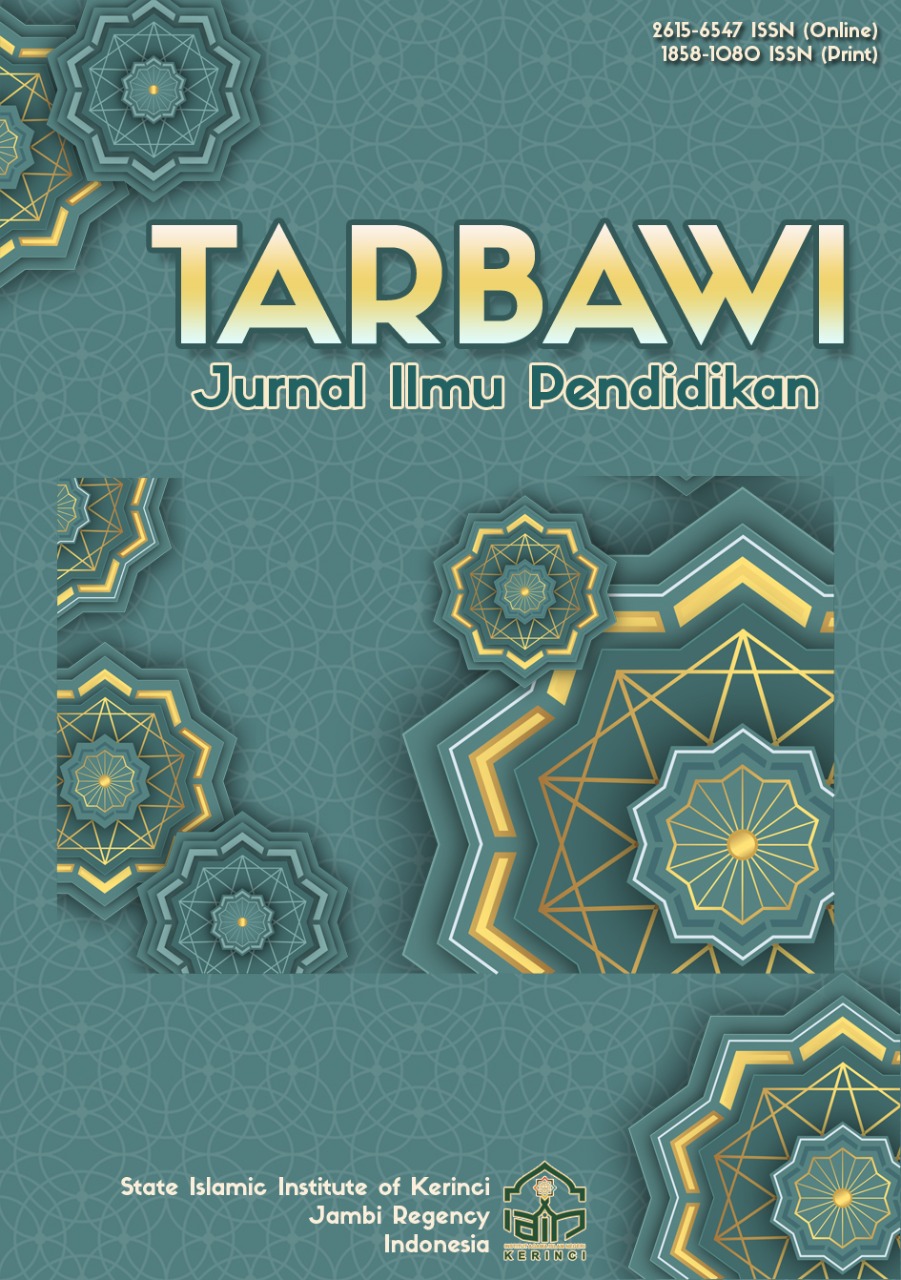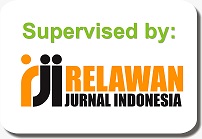Teaching the Rule of Product using Nature Tourism Routes
DOI:
https://doi.org/10.32939/tarbawi.v19i2.3168Keywords:
Design Research, Learning Trajectory, Nature Tourism Context, Realistics Mathematics Education, Rule of ProductAbstract
A tourism route is a sequence of tourist attractions visited. Students are familiar with tour activities and often plan tourism routes to visit several tourist attractions. Students' experience and knowledge about tourism routes can be used as a context for teaching the rule of product. Therefore, this research aims to design a learning trajectory for the rule of product using the Indonesian Realistic Mathematics Education (PMRI) approach in the Kerinci nature tourism route context. The research method used is design research with a validation study type, which consists of three stages: preparation and design, teaching experiment, and retrospective analysis. The subjects involved in this research were 11 third-semester mathematics education students at a university in Jambi, Indonesia. The instruments include learning video recordings, student work results, field notes, and test sheets. The research results show that learning trajectories designed in the context of tourism routes can help students discover, understand, and use the rule of product in solving relevant mathematical problems. The learning tracjectory consists of four activities: making a list of Kerinci tourist attractions, determining the location of several tourist attractions on a sketch map, arranging tourist attractions in tourism routes, and solving problems regarding possible tourism routes. This research shows that the designed learning trajectory is vital in helping students discover and understand the rule of product and apply them to solving relevant problems.
Downloads
References
Antonides, J., & Battista, M. T. (2022). A learning trajectory for enumerating permutations: Applying and elaborating a theory of levels of abstraction. The Journal of Mathematical Behavior, 68, 101010. https://doi.org/10.1016/j.jmathb.2022.101010
Antonides, J., & Battista, M. T. (2022). Towards an elaboration of concreteness fading: Reflections on a constructivist teaching experiment. In Proceedings of the 44th annual meeting of the North American Chapter of the International Group for the Psychology of Mathematics Education. Middle Tennessee State University.
Awaritefe, O. (2004). Motivation and other considerations in tourist destination choice: A case study of Nigeria. Tourism Geographies, 6(3), 303-330. https://doi.org/10.1080/1461668042000249638
Bakker, A. (2018). Design research in education: A practical guide for early career researchers. Routledge. https://www.routledge.com/Design-Research-in-Education-A-Practical-Guide-for-Early-Career-Researchers/Bakker/p/book/9781138574489
Barnes, H. (2005). The theory of Realistic Mathematics Education as a theoretical framework for teaching low attainers in mathematics. Pythagoras, 2005(61), 42-57. https://doi.org/10.4102/pythagoras.v0i61.120
Batanero, C., & Sanchez, E. (2005). What is the Nature of High School Students' Conceptions and Misconceptions About Probability?. In Jones, G. A. (Eds). Exploring probability in school: Challenges for teaching and learning (pp. 241-266). Springer. https://doi.org/10.1007/0-387-24530-8_11
Chan, C. M. E. (2013). Students’ designing an ideal tourism route as mathematical modelling. In G. Stillman, G. Kaiser, W. Blum, & J. Brown. (Eds). Teaching mathematical modelling: Connecting to research and practice (pp. 153-163). Springer. https://doi.org/10.1007/978-94-007-6540-5_13
Charalambides, C.A. (2002). Enumerative Combinatorics (1st ed.). Chapman and Hall/CRC. https://doi.org/10.1201/9781315273112
Chotikarn, N., Kanhapong, A., Tupsai, J., & Yuenyong, C. (2021, March). Enhancing Grade 11 students’ representation and connection in permutation and combination for their problem solving. In Journal of Physics: Conference Series (Vol. 1835, No. 1, p. 012023). IOP Publishing. https://doi.org/10.1088/1742-6596/1835/1/012023
Clements, D. H., Sarama, J., Baroody, A. J., Joswick, C., & Wolfe, C. B. (2019). Evaluating the efficacy of a learning trajectory for early shape composition. American Educational Research Journal, 56(6), 2509-2530. https://doi.org/10.3102/0002831219842788
Gionis, A., Lappas, T., Pelechrinis, K., & Terzi, E. (2014, February). Customized tour recommendations in urban areas. In Proceedings of the 7th ACM International Conference on Web Search and Data Mining (pp. 313-322). https://ssrn.com/abstract=2465142
Gravemeijer, K., & Cobb, P. (2006). Design research from a learning design perspective. In J. van den Akker, K. Gravemeijer, S. Mckenney, & N. Nieveen (Eds.). Educational Design Research (pp. 15-51). Routledge. https://doi.org/10.4324/9780203088364
Gravemeijer, K., & van Eerde, D. (2009). Design research as a means for building a knowledge base for teachers and teaching in mathematics education. The Elementary School Journal, 109(5), 510-524. https://doi.org/10.1086/596999
Haddouche, H., & Salomone, C. (2018). Generation Z and the tourist experience: tourist stories and use of social networks. Journal of Tourism Futures, 4(1), 69-79. https://doi.org/10.1108/JTF-12-2017-0059
Hajian, S. (2019). Transfer of learning and teaching: A review of transfer theories and effective instructional practices. IAFOR Journal of Education, 7(1), 93-111. https://doi.org/10.22492/ije.7.1.06
Hernandez-Martinez, P., & Vos, P. (2018). “Why do I have to learn this?” A case study on students’ experiences of the relevance of mathematical modelling activities. ZDM Mathematics Education, 50, 245-257. https://doi.org/10.1007/s11858-017-0904-2
Jonassen, D. H. (2000). Toward a design theory of problem solving. Educational Technology Research and Development, 48(4), 63-85. https://doi.org/10.1007/BF02300500
Kimani, P. M., Gibbs, R. T., & Anderson, S. M. (2013). Restoring order to permutations and combinations. Mathematics Teaching in the Middle School, 18(7), 430-438. https://doi.org/10.5951/mathteacmiddscho.18.7.0430
Lewis, R., & Carroll, F. (2016). Creating seating plans: a practical application. Journal of the Operational Research Society, 67(11), 1353-1362. https://doi.org/10.1057/jors.2016.34
Liu, A. S., & Schunn, C. D. (2017). Applying math onto mechanisms: Mechanistic knowledge is associated with the use of formal mathematical strategies. Cognitive Research: Principles and Implications, 2(6), 1-13. https://doi.org/10.1186/s41235-016-0044-1
Matitaputty, C., Nusantara, T., & Hidayanto, E. (2022). Examining the pedagogical content knowledge of in-service mathematics teachers on the permutations and combinations in the context of student mistakes. Journal on Mathematics Education, 13(3), 393-414. https://doi.org/10.22342/jme.v13i3.pp393-414
Mumcu, H. Y. (2016). Using Mathematics, Mathematical Applications, Mathematical Modelling, and Mathematical Literacy: A Theoretical Study. Journal of Education and Practice, 7(36), 80-96. https://iiste.org/Journals/index.php/JEP/article/view/34638
Palmér, H., & van Bommel, J. (2022, May). Young students’ choice of representation when solving a problem-solving task on combinatorics. In A Mathematics Education Perspective on early Mathematics Learning – POEM 2022 Gothenburg. Sweden. https://www.kau.se/files/2022-05/POEM_Palme%CC%81r_vanBommel.pdf
Plomp, T. (2007). Educational Design Research. In T. Plomp & N. Nieveen (Eds). An introduction to educational design research (pp. 9-35). SLO. https://slo.nl/publish/pages/4474/educational-design-research-part-a.pdf
Putra, A., Zulkardi, Z., Putri, R. I. I., & Nusantara, D. S. (2023). Scoping Literature Review: What Activities Can Help Students Discover Permutations?. Edumatika : Jurnal Riset Pendidikan Matematika, 6(2). https://doi.org/10.32939/ejrpm.v6i2.3167
Sembiring, R. K., Hadi, S., & Dolk, M. (2008). Reforming mathematics learning in Indonesian classrooms through RME. ZDM Mathematics Education, 40, 927-939. https://doi.org/10.1007/s11858-008-0125-9
Sitorus, J. (2016). Students’ creative thinking process stages: Implementation of realistic mathematics education. Thinking Skills and Creativity, 22, 111-120. https://doi.org/10.1016/j.tsc.2016.09.007
Szydlik, J. E. (2000). Photographs and committees: Activities that help students discover permutations and combinations. The Mathematics Teacher, 93(2), 93-96. https://doi.org/10.5951/MT.93.2.0093
Usry, R., Rosli, R., & Maat, S. M. (2016). An error analysis of matriculation students’ permutations and combinations. Indian Journal of Science and Technology, 9(4), 1-6. https://doi.org/10.17485/ijst/2016/v9i4/81793
van Bommel, J., & Palmér, H. (2021). Enhancing young children’s understanding of a combinatorial task by using a duo of digital and physical artefacts. Early Years, 41(2-3), 218-231. https://doi.org/10.1080/09575146.2018.1501553
van den Heuvel-Panhuizen, M., & Drijvers, P. (2020). Realistic Mathematics Education. In S. Lerman (Ed.). Encyclopedia of Mathematics Education (pp. 713-717). Springer. https://doi.org/10.1007/978-3-030-15789-0_170
van Eerde, D. (2013, April). Design research: Looking into the heart of mathematics education. In Zulkardi (Ed). Proceeding The First South East Asia Design/Development Research (SEA-DR) International Conference. (pp. 1-11). UNSRI, Palembang. https://repository.unsri.ac.id/5988/1/k1_dolly_10.pdf
Verschaffel, L., Greer, B., & De Corte, E. (2002). Everyday knowledge and mathematical modeling of school word problems. In K. Gravemeijer, R. Lehrer, B. Oers, & L. Verschaffel (Eds). Symbolizing, modeling and tool use in mathematics education (pp. 257-276). Springer. https://doi.org/10.1007/978-94-017-3194-2_16
Vinogradova, I. (2019). Multi-attribute decision-making methods as a part of mathematical optimization. Mathematics, 7(10), 915. https://doi.org/10.3390/math7100915
Vinner, S. (2011). The role of examples in the learning of mathematics and in everyday thought processes. ZDM Mathematics Education, 43, 247-256. https://doi.org/10.1007/s11858-010-0304-3
Voigt, J. (2013). Negotiation of mathematical meaning in classroom processes: Social interaction and learning mathematics. In L. P. Steffe et al. (Eds). Theories of mathematical learning (pp. 21-50). Routledge. https://doi.org/10.4324/9780203053126
Waller, P. P., & Flood, C. T. (2016). Mathematics as a universal language: transcending cultural lines. Journal for Multicultural Education, 10(3), 294-306. https://doi.org/10.1108/JME-01-2016-0004
Younas, I., Kamrani, F., Bashir, M., & Schubert, J. (2018). Efficient genetic algorithms for optimal assignment of tasks to teams of agents. Neurocomputing, 314, 409-428. https://doi.org/10.1016/j.neucom.2018.07.008
Zulkardi & Putri, R. I. I. (2019). New School Mathematics Curricula, PISA and PMRI in Indonesia. In C. Vistro-Yu & T. Toh (Eds). School Mathematics Curricula. Mathematics Education – An Asian Perspective. Springer. https://doi.org/10.1007/978-981-13-6312-2_3
Downloads
Published
Issue
Section
License
Copyright (c) 2023 Aan Putra, Zulkardi Zulkardi, Ratu Ilma Indra Putri, Elly Susanti, Duano Sapta Nusantara

This work is licensed under a Creative Commons Attribution-ShareAlike 4.0 International License.









